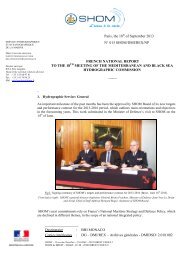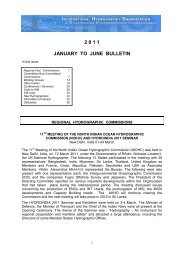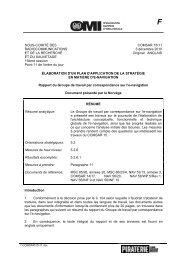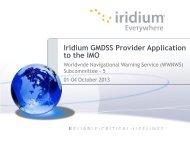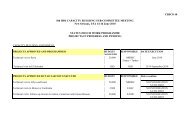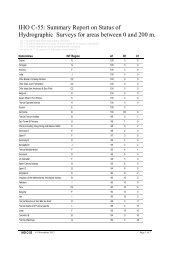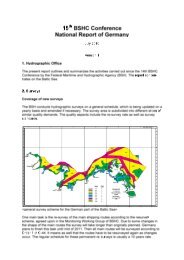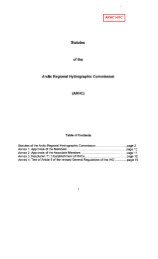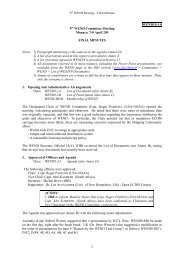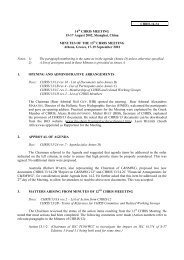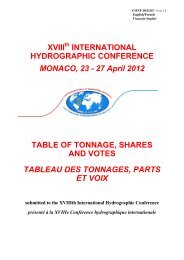Report - IHO
Report - IHO
Report - IHO
You also want an ePaper? Increase the reach of your titles
YUMPU automatically turns print PDFs into web optimized ePapers that Google loves.
3<br />
safety of navigation and national economic development was raised through data collection,<br />
charts production and maritime safety information. More than 80% of the world goods by<br />
volume are transferred by maritime transport. Penalties for inactivity in hydrography were<br />
reminded: risk of increase in marine accidents, lack of confidence from shipping companies in<br />
ports and routes, limitation of international trade, missed economic opportunities,<br />
environmental impacts, liability and litigation. He invited delegates to express assistance<br />
requests in order to establish their own hydrographic capability to meet their obligations under<br />
SOLAS Regulations.<br />
Importance of nautical information<br />
Morning session<br />
Hydrography: International Obligations on States (Alexandros Maratos, IHB)<br />
Obligations and commitments under SOLAS and UN Resolutions were developed and States<br />
responsibilities were stressed:<br />
• Mariners obligations<br />
SOLAS (V/19) carriage requirements for navigation equipment,<br />
SOLAS (V/27) nautical charts and publications,<br />
• Government obligations<br />
SOLAS (V/9) provision of hydrographic services,<br />
SOLAS (V/4) navigational warning.<br />
The lecturer highlighted the role of <strong>IHO</strong> in assisting countries of the SAIHC area to meet their<br />
SOLAS obligations. These obligations could be met directly via governments, bi-lateral<br />
assistance from other States or using commercial support providers.<br />
Hydrographic survey is a necessity if Coastal States are to meet their obligations under the<br />
SOLAS Convention for safety of life at sea and protection of the environment but it is also an<br />
important means to facilitate economic development. The benefits of hydrography for Coastal<br />
States were then presented.<br />
Roles and Functions of the <strong>IHO</strong> (Alexandros Maratos, IHB)<br />
Roles, functions and organization of the International Hydrographic Organization, the<br />
International Hydrographic Bureau (IHB) and the Regional Hydrographic Commissions<br />
(RHC) were explained.<br />
The benefits of RHC membership (as Member States, associate members or observers) were<br />
emphasized in relation to benefiting from Capacity Building assistance. <strong>IHO</strong> membership<br />
should be similar to IMO.<br />
<strong>IHO</strong> Capacity Building and Developing Hydrographic Capabilities (Alexandros Maratos,<br />
IHB)<br />
The building of hydrographic capacity allows Coastal States of the SAIHC region to meet<br />
their SOLAS international obligations. Capacity Building Funds, activities and work program<br />
were introduced. Capacity Building principles and processes are built around the four<br />
following steps: awareness (raising importance of hydrography), assessment (identification),<br />
analysis (prioritization) and action. The last step, corresponding to the building of<br />
hydrographic capacity was then developed:<br />
Collection and circulation of information to maintain existing charts and publications:<br />
every State can (and must) get to this phase.<br />
3



